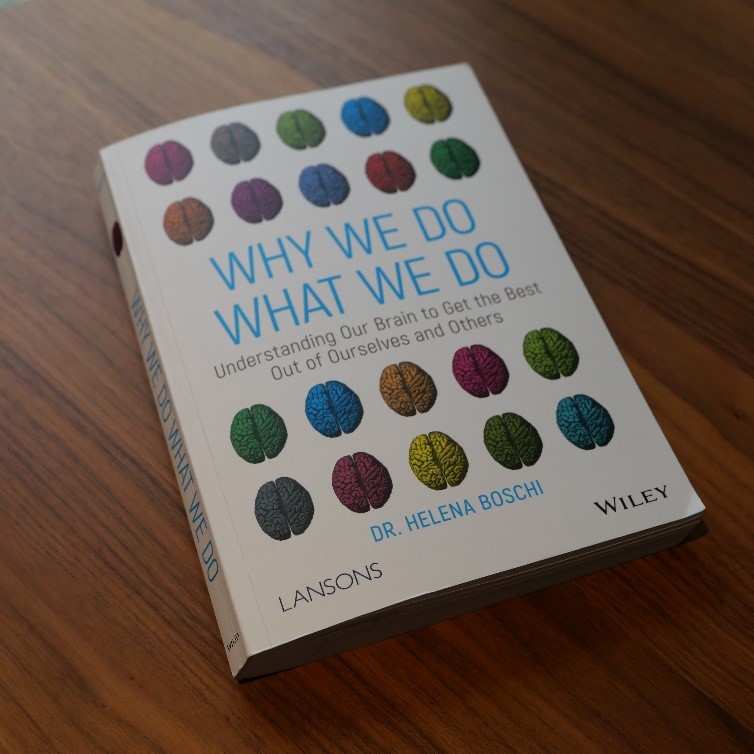Review: Why We Do What We Do

About the author
Kevin is a co-founder of PR Academy and editor/co-author of Exploring Internal Communication published by Routledge. Kevin leads the CIPR Internal Communication Diploma course. PhD, MBA, BA Hons, PGCE, FCIPR, CMgr, MCMI.

Why We Do What We Do: Understanding Our Brain to Get the Best Out of Ourselves and Others
By Dr Helena Boschi
John Wiley & Sons with Lansons, 2020, 308 pages
This book by a psychologist who specialises in applying neuroscience to business is a great read for anyone interested in a basic understanding of how the brain works.
The book follows a very clear and digestible structure, each chapter exploring a different aspect of the brain. The science is explained in simple language with very good use of diagrams and examples of experiments that have established contemporary knowledge. Each chapter examines the impact of brain function on daily life and then provides stories and tips to reinforce how brain functioning impacts what we do.
The ways that psychology informs public relations practice have always been a personal interest. I was studying for my degree in psychology with the Open University at the same time as moving into a public relations role at BT in the mid-1990s. Many of the core principles that were taught on that programme re-appear in this book, although they are, of course, complemented with new perspectives and more up to date research.
But all the fundamentals are there and as I read through each chapter, I found myself wondering (again) why applied psychology is not discussed more in PR circles. After all, emotions, memory, attention, language, storytelling, visual perception, biases, and habits are the stuff of everyday PR plans and campaigns. These topics are covered in separate chapters and in addition there are useful chapters on stress, leadership and how to protect the brain against daily challenges with a focus on sleep, exercise and food.
The chapters on language, visual perception and biases are, perhaps, the most useful for applied public relations practice.
As we know, language is complex. As Boschi outlines, language is a result of a sophisticated series of connections that extend across the whole brain. An example provided is the way that the brain separates word processing into the left temporal lobe of the brain and intonation into the right side of the brain.
Take the phrase ‘I didn’t say he should stroke the dog’. This results in seven potential different meanings depending which word in the phrase is emphasised (see two of the possible meanings below). This complexity is probably why natural language processing is still relatively limited.
| Emphasis | Meaning |
| I didn’t say he should stroke the dog | I implied it, pointed it out or wrote it down |
| I didn’t say he should stroke the dog | He should just look at the dog |
The chapter on language includes some good tips on words to avoid – because the brain converts words into visual associations almost immediately. The use of ‘don’t’ is an example. If you say ‘don’t spill that drink’ the brain visualises a spilled drink and that could then transfer to behaviour in spilling the drink!
The chapter on visual perception includes sections on shapes, facial recognition, illusions and body image. The chapter on the brain and biases covers the most well-known biases, such as: loss aversion, confirmation bias, hindsight bias, optimism bias, overconfidence bias, present bias, in-group/out-group bias, negativity bias and authority bias. There are also useful summary discussions of framing, priming and nudge theory.
A chapter on change reminds internal communication managers that change means pain for the brain and the way that anxiety is contagious. The emphasis on leadership focusing on the ‘why’ and the way that employees are consulted and informed is well articulated.
This is not a book that goes deep into the ways that neuroscience is currently used (or not) in public relations and communication management. It is, however, a book that provides admirable breadth in explaining why we do what we do.
Discount code for PR Place Insights readers
There is a special offer for PR Place Insights readers. Use this code to get a 20% discount when you buy the book via Lansons website use the code PRACADEMY20 at checkout.